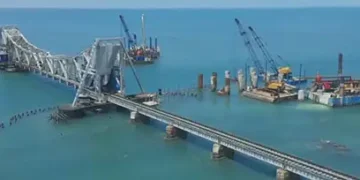P rime Minister Narendra Modi’s landmark visit to Mizoram and Manipur embodied the convergence of infrastructure development with healing, marking a pivotal moment in India’s Northeast transformation. Central to this narrative was PM Modi’s inaugural return to Manipur since the devastating 2023 ethnic violence, underscoring the Government’s intent to leverage large-scale infrastructure projects as both economic catalysts and peace-building instruments.
The visit signalled a new era of stability and growth, where the spools of railway tracks weave together economic opportunity and communal reconciliation. The inauguration of the Rs 8,070-crore Bairabi-Sairang railway, stitching Aizawl into the national grid, alongside the unveiling of over Rs 17,000 crore in regional projects, was a pointed reminder that for the Modi administration, infrastructure is not just policy; it is doctrine and stability and growth are to be engineered, quite literally, from the ground up.
The choreography of PM Modi’s Northeast foray was deliberate: development is to be the principal vehicle for both conflict resolution and regional integration. By choosing to inaugurate the Bairabi-Sairang railway, a feat of 48 tunnels and 143 bridges, the PM was sending a message that the Government’s resolve to connect the nation is not to be doubted. The railway’s completion, after years of geological intransigence and technical labyrinths, is a case study in what sustained political will can achieve. Railway Minister Ashwini Vaishnaw’s remarks on the project’s technical know-how, tunnelling through sand that had to be coaxed into stone, only underscored the extraordinary lengths taken to weave Mizoram into the national economic fabric.
In addition, the immediate launch of three new Express services further reinforced this integration, providing Mizoram’s residents with direct access to India’s major economic centres. PM Modi’s first visit since the May 2023 ethnic violence represented a critical intervention. The Prime Minister decided to visit Churachandpur, the epicentre of Kuki-Zo-Meitei tensions, and interact directly with internally displaced persons, signaling a hands-on approach to conflict resolution that goes beyond traditional administrative responses.
In addition, the recently signed revised Suspension of Operations pact with 24 Kuki-Zo insurgent groups provided crucial context for the timing and significance of this visit. Signed on September 4, just days before PM Modi’s arrival, this agreement reduces militant camps from 14 to six each for the Kuki National Organisation and United People’s Front, while ensuring strict monitoring through Aadhaar-linked financial systems and foreign national identification processes.
The combination of suspending operations, direct engagement with displaced persons, and the announcement of Rs 8,500 crore in new projects for Manipur highlighted the Government’s belief that economic opportunities and infrastructure can provide alternatives to ethnic conflict. The region’s 5,182-kilometre border with China, Myanmar, Bangladesh, and Bhutan makes infrastructure development essential for both defensive capabilities and diplomatic engagement through India’s ‘Act East’ policy.
PM Modi’s peace-building through development marks a shift from earlier security-centric strategies that alienated locals. Signing over a dozen accords since 2014, such as with the Bodo, Bru-Reang, Karbi Anglong, and ULFA groups, demonstrates the belief that comprehensive development can counter insurgency and ethnic conflict. The new Kuki-Zo pact continues the approach of blending security with economic opportunity. The visit culminated more than a decade of systematic Northeast transformation that has fundamentally altered the region’s relationship with both the Indian State and the broader global economy.
































